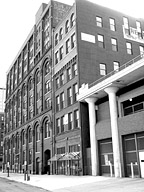
Once a warehouse for a clothing manufacturer and a hardware supplier, the building has a façade that speaks of a prosperous era in Cleveland's past. But don't let this 94,000-sq-ft structure's industrial exterior fool you. With renovations made to the internal and external architecture and a new HVAC system in place, Lakeside Development now boasts contemporary appeal with spacious floor plans and state-of-the-art utilities. A high-profile project with a tight deadline, Lakeside Development required skilled contractors to get the job done fast and done right.
Multiple Guttings
From the architect's point of view, the team had their work cut out for them, quite literally. "When we got involved, the building had been gutted many times," said Mark Benton, Lakeside Development's project manager from SchmidtCopelandParkerStevens Architects.The open floor layout, common to an industrial warehouse, left little in the way of renovation problems for the architects of Cleveland-based Vector who concentrated on the interior design of the building. The interior had a lackluster appearance, as decorative details of any sort were deemed unnecessary for an industrial warehouse.
While the details were minimal, the industrial design posed some problems for installing new ductwork. Gus Georgalis, owner of Lakeside Development, said he wanted to preserve the industrial look and feel by leaving ceiling beams exposed and installing ductwork around them. This provided a challenge for the mechanical contractor, Imperial Heating, as there was little space above the beams in which to install ductwork. Todd Ozanich, president of Imperial, said the solution was to choose round ductwork as it could more easily accommodate the tight, twisting duct layout of the space.
"There were many situations where we had to go up and over structural beams," said Ozanich. "The owner didn't want to remove the beams for aesthetic reasons, so we had to convert from round to flat oval in some cases to accommodate tighter spaces."
Historic Holdups
Ozanich said the ability of Lindab's SPIROsafe to transition from round to oval and back to round was also a timesaver. "Because of its self-sealing gaskets, it fits together nicely without having to use duct sealant," he said.Due to the historical significance of the building, a solid chunk of time was dedicated to the legalities of preserving its value. This in turn held up construction, which reduced the time Imperial Heating had to install the ductwork. Ozanich said because Lakeside Development was a high-profile project that demanded a quick turnaround, the time saved installing the duct system was key to meeting the project's deadline. Additionally, because Lindab's distributors are required to keep a local inventory of SPIROsafe products, Air Control Products was able to deliver the products within 24 hours of the contractor's request.
The shell of the complex represents a significant time in the history of Cleveland when the Industrial Revolution was flourishing, and commercial warehouse construction was booming to accommodate new business. Lakeside Development was once part of the George Worthington Complex, housing the Worthington Company, most notable for providing tools and supplies for the Erie Canal's construction.
Interestingly enough, although the building was built purely for function, the original architect, who remains unknown, included Italianate features on the exterior: graceful stone detailing at lintels and cornices, and curving arch top windows. Both features add elegance to an otherwise very basic structure. Benton left most of these features in place, while rehabilitating the building to modern standards.
With all the progress at Lakeside Development, Georgalis has exciting plans in store for the rest of the complex. Included in those plans are a possible wine bar and jazz club located at the basement level, and more commercial spaces for the third floor. Currently, the building has space allocated for restaurants, offices, and apartment suites, making it a desirable complex for tenants and the community alike.
